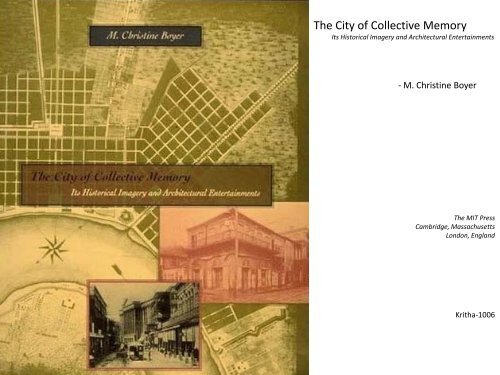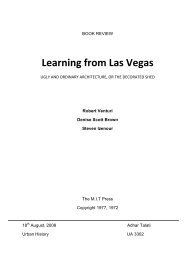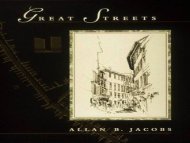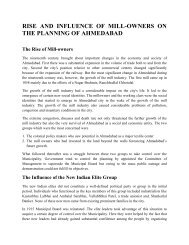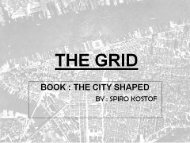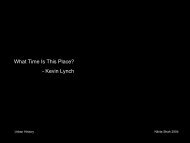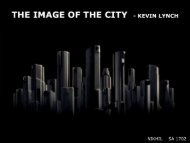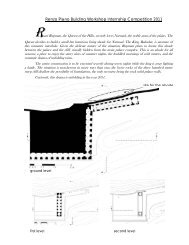The City of Collective Memory
The City of Collective Memory
The City of Collective Memory
Create successful ePaper yourself
Turn your PDF publications into a flip-book with our unique Google optimized e-Paper software.
<strong>The</strong> <strong>City</strong> <strong>of</strong> <strong>Collective</strong> <strong>Memory</strong><br />
Its Historical Imagery and Architectural Entertainments<br />
- M. Christine Boyer<br />
<strong>The</strong> MIT Press<br />
Cambridge, Massachusetts<br />
London, England<br />
Kritha-1006
• “<strong>Collective</strong> <strong>Memory</strong>” , in general, refers to shared memories <strong>of</strong> a particular group or family<br />
framed in space and time.<br />
Eg. <strong>Collective</strong> <strong>Memory</strong> <strong>of</strong> a nation is represented partly by the memorials it chooses to erect.<br />
Whatever a nation chooses to memorialise in a physical monument is an indicator <strong>of</strong> its<br />
collective memory.<br />
• <strong>The</strong> city is a colllective expression <strong>of</strong> architecture and it carries the memory traces <strong>of</strong> earlier<br />
architectural forms, city plans and public monuments.<br />
• <strong>The</strong> physical structure <strong>of</strong> a city always evolves ,being deformed or forgotten, adapted to<br />
other purposes or eradicated by different needs.
<strong>The</strong> Generating Powers <strong>of</strong> a <strong>City</strong> Plan<br />
• <strong>The</strong> contemporary city suffers from an inadequate and misguided process <strong>of</strong> planning, and so<br />
the reexamination <strong>of</strong> some <strong>of</strong> the latter’s historical roots might awaken forgotten intentions.<br />
• Behind every city plan lies a belief that society is progressing towards a better future.<br />
• A city should become the locus <strong>of</strong> collective memory and not simply an outdoor museum or<br />
a collection <strong>of</strong> historical districts.
Inversion <strong>of</strong> Public & Private Space<br />
• <strong>The</strong> word “public” is misrepresented when applied to city places.<br />
• Before the end <strong>of</strong> 18 th century public space was usually designed as an honorific place to celebrate<br />
the power <strong>of</strong> the king, queen or aristocracy holding tableaux vivants.<br />
• Due to the revolutions in the 18th and 19th centuries, public spaces became democratic spheres<br />
where public space was extended to include places <strong>of</strong> public debates and gatherings.<br />
• Public authority was linked to a system <strong>of</strong> norms and regulations.<br />
• Throughout the 19 th century, illiterate class grew in numbers, the public sphere was<br />
reconceptualised in terms <strong>of</strong> the rich and the poor.<br />
• With the beginning <strong>of</strong> the 20 th century, municipal buildings, public libraries, railroad stations, public<br />
parks etc came up to establish beauty & order.
• In the last few decades, “public” has become a negative concept comprising <strong>of</strong> unruly<br />
bureaucracies, corrupt <strong>of</strong>ficials, inefficient management.<br />
• “Private” has been refurbished with a new image: freedom <strong>of</strong> choice and style.<br />
• Civic improvement schemes play on this inversion <strong>of</strong> values- creating private preserves for<br />
the wealthy which are transformed into “public amenities”.<br />
• Thus, city’s public is fragmented into marginalised groups.
<strong>City</strong> Images & Representional Forms<br />
• 3 aesthetic conventions representing the image <strong>of</strong> cities in the traditional, modern &<br />
contemporary time periods are identified: 1. <strong>The</strong> <strong>City</strong> as a Work <strong>of</strong> Art,<br />
2. <strong>The</strong> <strong>City</strong> as Panorama,<br />
3. <strong>The</strong> <strong>City</strong> <strong>of</strong> Spectacle.
<strong>The</strong> <strong>City</strong> as a Work <strong>of</strong> Art<br />
• Until the end <strong>of</strong> the 19 th century, builders <strong>of</strong> modern<br />
industrial cities were absorbed with picture-making.<br />
• This picture frame became emblematic <strong>of</strong> its unified<br />
and closed spatial order.<br />
• This period witnessed an architecture <strong>of</strong> ceremonial<br />
power whose monuments spoke <strong>of</strong> exemplary deeds,<br />
national unity and industrial glory.<br />
• <strong>The</strong> <strong>City</strong> as a Work <strong>of</strong> Art was an attempt to fulfill<br />
cultural and aesthetic needs destroyed in the turmoil<br />
<strong>of</strong> progress.<br />
View <strong>of</strong> Palace de la Concorde
<strong>The</strong> <strong>City</strong> as Panorama<br />
• In the early 20 th century the city appeared as an open &<br />
expansive panorama, ruled by the transformation <strong>of</strong><br />
space & time that modern modes <strong>of</strong> travel provided.<br />
• <strong>The</strong> pictorial image <strong>of</strong> the <strong>City</strong> as a Work <strong>of</strong> Art was<br />
replaced by the city <strong>of</strong> soaring skyscrapers.<br />
• Railroad travel had erased the idea <strong>of</strong> in-between space.<br />
• Mobility in space thus enabled a juxtaposition <strong>of</strong><br />
disparate but sequential images.<br />
• So the city was no longer seen from a static frontal<br />
perspective, but as a multidimensional traveling view<br />
that was itself a new spatialization <strong>of</strong> space.<br />
Robert Delaunay, Eiffel Tower
<strong>The</strong> <strong>City</strong> <strong>of</strong> Spectacle<br />
• By the 1980s, the transformation <strong>of</strong> the material<br />
world by invisible bands <strong>of</strong> electronic communication.<br />
• It decomposed the bits and pieces <strong>of</strong> the city into an<br />
ephemeral form.<br />
• Art & architecture based on the recomposition &<br />
recombination <strong>of</strong> borrowed imagery appeared to<br />
make reality.<br />
• <strong>The</strong>re was a juxtapositioning <strong>of</strong> high and low art<br />
forms to give a sense <strong>of</strong> theatricality.<br />
• <strong>The</strong>re was revitalization <strong>of</strong> traditional building<br />
typologies or construction <strong>of</strong> new compositions.<br />
Paul Citroen, Metropolis
<strong>The</strong> Politics <strong>of</strong> Representational Forms<br />
• As every economic formation or structure engenders a cultural form or an aesthetic<br />
convention, the representational forms <strong>of</strong> the <strong>City</strong> as a Work <strong>of</strong> Art, Panorama, or Spectacle<br />
reflect different stages <strong>of</strong> capitalism.<br />
• <strong>The</strong> term “work <strong>of</strong> art” implied that there existed a market for these “works”, that art was a<br />
commodity for sale & no longer limited only to the aristocrats.<br />
• This 19 th century art market was compromised : the old aristocrats and acamedicians still<br />
ruled over popular taste.<br />
• To cover the changes wrought by political revolutions, industrialization, rise <strong>of</strong> capitalists with<br />
their materialistic aspirations, old styles such as Gothic, Baroque or Classical was used all over<br />
again.<br />
• Thus the battle <strong>of</strong> styles & the <strong>City</strong> as a work <strong>of</strong> art were nothing other than a backward<br />
binding gesture.
<strong>The</strong> <strong>City</strong> <strong>of</strong> <strong>Collective</strong> <strong>Memory</strong><br />
• <strong>The</strong> <strong>City</strong> <strong>of</strong> <strong>Collective</strong> <strong>Memory</strong> should focus on creation <strong>of</strong> meaningful & imaginative public<br />
spaces.<br />
• Should have continuous urban topography, a spatial structure that covers both rich and poor<br />
places, honorific and humble monuments, permanent and ephemeral forms, and should<br />
include places for public assemblage and public debate, as well as private memory walks and<br />
personal retreats.<br />
• In the <strong>City</strong> <strong>of</strong> <strong>Collective</strong> <strong>Memory</strong>, the architect, city planner, and spectator must begin to<br />
move beyond the will to instrumentally formulate historical unities.<br />
• It should have a play <strong>of</strong> oppositions, the existence <strong>of</strong> randomness, disturbances, dispersions<br />
& accidents.<br />
• <strong>The</strong> <strong>City</strong> <strong>of</strong> <strong>Collective</strong> <strong>Memory</strong> will require a double reading <strong>of</strong> 19 th & late 20 th century forms.


